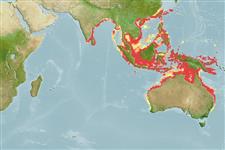>
Syngnathiformes (Pipefishes and seahorses) >
Syngnathidae (Pipefishes and seahorses) > Syngnathinae
Etymology: Hippocampus: Greek, ippos = horse + Greek,kampe = curvature (Ref. 45335); spinosissimus: Name from Latin word for winged, referring to the paired spines on the superior trunk ridges that are directed outward and have broad dermal flaps resembling wings (Ref. 42735).
More on author: Weber.
Environment: milieu / climate zone / depth range / distribution range
Ökologie
seewasser; brackwasser riff-verbunden; standorttreu; tiefenbereich 10 - 80 m (Ref. 42735). Subtropical; 22°C - 27°C (Ref. 130605); 27°N - 36°S, 76°E - 155°E
Indo-Pacific: India and Sri Lanka to Australia; north to China.
Length at first maturity / Size / Gewicht / Alter
Maturity: Lm 10.4 range ? - ? cm
Max length : 18.0 cm OT Männchen/unbestimmt; (Ref. 48635); 13.6 cm OT (female)
Rückenflossenstacheln (insgesamt): 0; Rückenflossenweichstrahlen (insgesamt): 16-20.
Found in the continental shelf, on muddy, sandy bottoms, rubbles and in coral reefs (Ref. 75154); in a sponge or seagrass habitat, often attached to hard and soft coral species (Ref. 128284). Ovoviviparous (Ref. 205). The male carries the eggs in a brood pouch which is found under the tail (Ref. 205). Maximum length is based on a straight-line length measurement from upper surface (ignoring spines) of first trunk ring, to tip of tail; female 13.8 cm (Ref. 42735). Less desirable for traditional Chinese medicine, but use may increase with the rise in patent medicines. Taken in trawls (Ref. 42735).
Male carries the eggs in a brood pouch (Ref. 205).
Lourie, S.A., R.A. Pollom and S.J. Foster, 2016. A global revision of the seahorses Hippocampus Rafinesque 1810 (Actinopterygii: Syngnathiformes): taxonomy and biogeography with recommendations for further research. Zootaxa 4146(1):1-66. (Ref. 115213)
IUCN Rote Liste Status (Ref. 130435)
Bedrohung für Menschen
Harmless
Nutzung durch Menschen
Aquarium: Kommerziell
Mehr Information
ReferenzenAquakulturAquakultur ProfilZuchtlinienGenetikElectrophoresesVererbbarkeitKrankheitenVerarbeitungNutrientsMass conversion
Tools
Zusatzinformationen
Download XML
Internet Quellen
Estimates based on models
Preferred temperature (Ref.
123201): 24.3 - 29.2, mean 28.3 °C (based on 992 cells).
Phylogenetic diversity index (Ref.
82804): PD
50 = 0.5000 [Uniqueness, from 0.5 = low to 2.0 = high].
Bayesian length-weight: a=0.00447 (0.00177 - 0.01127), b=3.00 (2.78 - 3.22), in cm total length, based on LWR estimates for this (Sub)family-body shape (Ref.
93245).
Trophic level (Ref.
69278): 3.4 ±0.5 se; based on size and trophs of closest relatives
Widerstandsfähigkeit (Ref.
120179): hoch, Verdopplung der Population dauert weniger als 15 Monate. (tm=0.5-1).
Fishing Vulnerability (Ref.
59153): Low vulnerability (10 of 100).
Nutrients (Ref.
124155): Calcium = 66.6 [31.9, 177.6] mg/100g; Iron = 0.848 [0.431, 1.529] mg/100g; Protein = 18.9 [17.6, 20.0] %; Omega3 = 0.209 [0.109, 0.393] g/100g; Selenium = 18.3 [7.4, 43.1] μg/100g; VitaminA = 39.7 [10.8, 147.1] μg/100g; Zinc = 1.27 [0.77, 1.98] mg/100g (wet weight);
